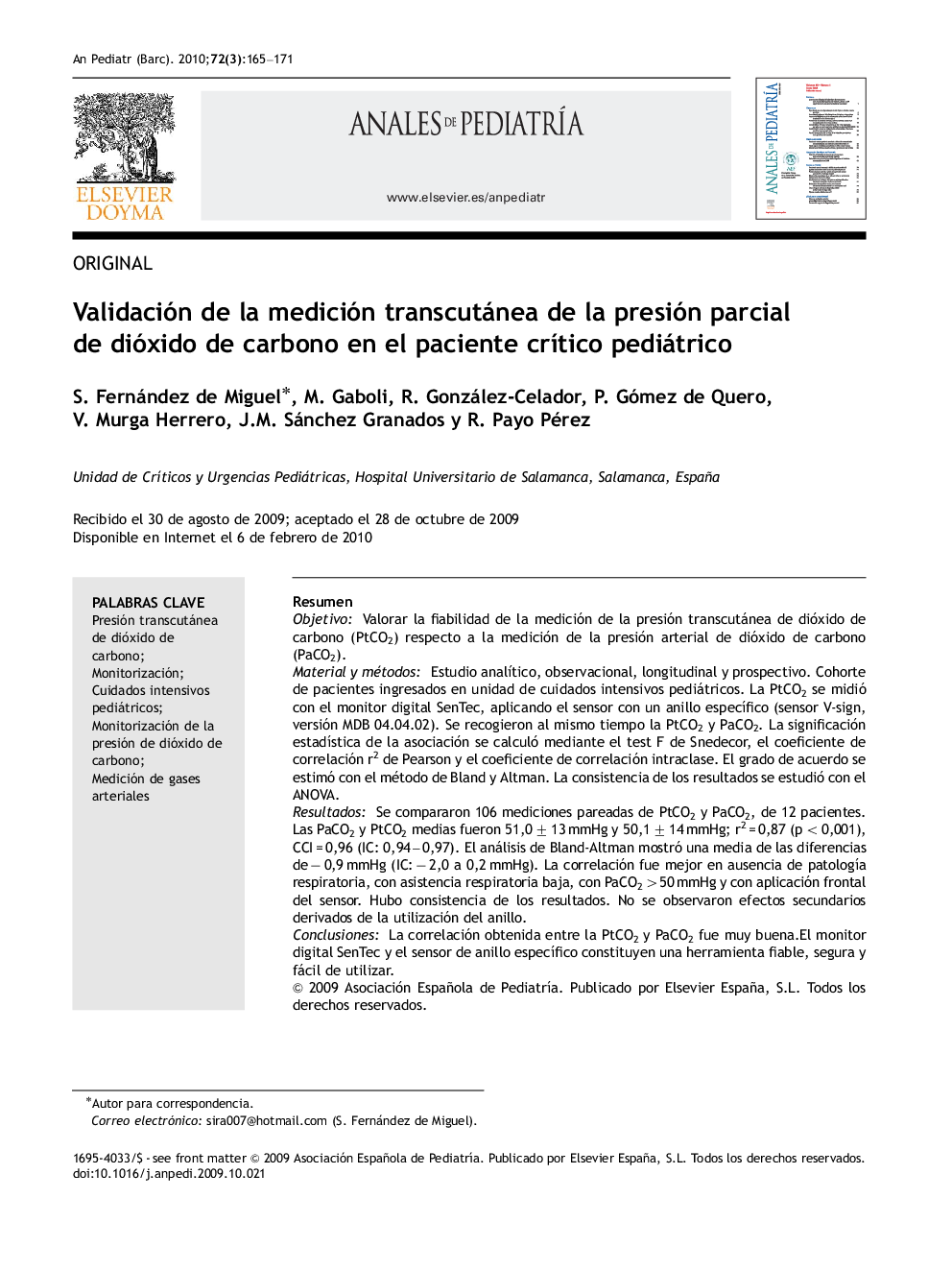| کد مقاله | کد نشریه | سال انتشار | مقاله انگلیسی | نسخه تمام متن |
|---|---|---|---|---|
| 4143314 | 1272403 | 2010 | 7 صفحه PDF | دانلود رایگان |

ResumenObjetivoValorar la fiabilidad de la medición de la presión transcutánea de dióxido de carbono (PtCO2) respecto a la medición de la presión arterial de dióxido de carbono (PaCO2).Material y métodosEstudio analítico, observacional, longitudinal y prospectivo. Cohorte de pacientes ingresados en unidad de cuidados intensivos pediátricos. La PtCO2 se midió con el monitor digital SenTec, aplicando el sensor con un anillo específico (sensor V-sign, versión MDB 04.04.02). Se recogieron al mismo tiempo la PtCO2 y PaCO2. La significación estadística de la asociación se calculó mediante el test F de Snedecor, el coeficiente de correlación r2 de Pearson y el coeficiente de correlación intraclase. El grado de acuerdo se estimó con el método de Bland y Altman. La consistencia de los resultados se estudió con el ANOVA.ResultadosSe compararon 106 mediciones pareadas de PtCO2 y PaCO2, de 12 pacientes. Las PaCO2 y PtCO2 medias fueron 51,0 ± 13 mmHg y 50,1 ± 14 mmHg; r2 = 0,87 (p < 0,001), CCI = 0,96 (IC: 0,94 – 0,97). El análisis de Bland-Altman mostró una media de las diferencias de − 0,9 mmHg (IC: − 2,0 a 0,2 mmHg). La correlación fue mejor en ausencia de patología respiratoria, con asistencia respiratoria baja, con PaCO2 >50 mmHg y con aplicación frontal del sensor. Hubo consistencia de los resultados. No se observaron efectos secundarios derivados de la utilización del anillo.ConclusionesLa correlación obtenida entre la PtCO2 y PaCO2 fue muy buena.El monitor digital SenTec y el sensor de anillo específico constituyen una herramienta fiable, segura y fácil de utilizar.
ObjectiveTo estimate the accuracy of the transcutaneous carbon dioxide tension measurement (PtCO2) compared to the measurement of the arterial carbon dioxide tension (PaCO2).Material and methodsAn analytical, longitudinal, prospective and observational study, of a dynamic cohort taken from the in-patients of a Paediatric Intensive Care Unit (PICU). The PtCO2 was measured with the SenTec AG analyzer, and the sensor was applied with the specific Multi-Site Attachment Ring. PtCO2 and PaCO2 were recorded at the same time. The statistical significance of the association between paired measurements was evaluated with the Snedecor's F test, the Pearson's r2 correlation coefficient and the Interclass Correlation Coefficient (ICC). The degree of agreement was evaluated with the Bland & Altman method. The consistency of the results was evaluated with the ANalysis Of the VAriance (ANOVA).ResultsOne hundred and six paired measurements, PtCO2 and PaCO2, from twelve patients, were compared. The means of the PaCO2 and PtCO2 were 51.0 ±13 mmHg and 50.1 ± 14 mmHg, respectively; r2 = 0.87 (p < 0.001), ICC = 0.96, (95% CI: 0.94 – 0.97). The Bland-Altman analysis showed a mean difference of − 0.9 mmHg (95% CI: − 2.0 to 0.2 mmHg). The correlation was better in cases with no respiratory disease, with low respiratory assistance, with PaCO2 > 50 mmHg and with the sensor applied on the forehead. The results were consistent. No side effects derived from the use of the ring were observed.ConclusionThe correlation between PtCO2 and PaCO2 is excellent and stable. The ring sensor was safe and easy to use.
Journal: Anales de Pediatría - Volume 72, Issue 3, March 2010, Pages 165–171